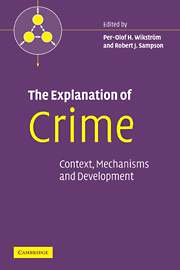Description
The Explanation of Crime
Context, Mechanisms and Development
Pathways in Crime Series
Coordinators: Wikström Per-Olof H., Sampson Robert J.
An analysis of the roles of behavioural contexts and individual differences in crime causation.
Language: English
The explanation of crime: context, mechanisms and development
Publication date: 11-2006
324 p. · 15.7x23.5 cm · Hardback
Publication date: 11-2006
324 p. · 15.7x23.5 cm · Hardback
The explanation of crime: context, mechanisms and development
Publication date: 09-2009
324 p. · 15.2x22.9 cm · Paperback
Publication date: 09-2009
324 p. · 15.2x22.9 cm · Paperback
Description
/li>Contents
/li>
Integration of disciplines, theories and research orientations has assumed a central role in criminological discourse yet it remains difficult to identify any concrete discoveries or significant breakthroughs for which integration has been responsible. Concentrating on three key concepts: context, mechanisms, and development, this volume aims to advance integrated scientific knowledge on crime causation by bringing together different scholarly approaches. Through an analysis of the roles of behavioural contexts and individual differences in crime causation, The Explanation of Crime seeks to provide a unified and focused approach to the integration of knowledge. Chapter topics range from individual genetics to family environments and from ecological behaviour settings to the macro-level context of communities and social systems. This is a comprehensive treatment of the problem of crime causation that will appeal to graduate students and researchers in criminology and be of great interest to policy-makers and practitioners in crime policy and prevention.
Introduction: Toward a unified approach to crime and its explanation Per-Olof H. Wikström and Robert J. Sampson; 1. A systematic perspective on crime Mario Bunge; 2. How does community context matter? Social mechanisms and the explanation of crime rates Robert J. Sampson; 3. Individuals, settings and acts of crime: situational mechanisms and the explanation of crime Per-Olof H. Wikström; 4. Evidence from behavioral genetics for environmental contributions to antisocial conduct Terrie Moffitt and Avshalom Caspi; 5. A three-dimensional, cumulative developmental model of serious delinquency Rolf Loeber, N. Wim Slot and Magda Stouthamer-Loeber; 6. Self-control and social control of deviant behavior in context: development and interactions along the life course Marc LeBlanc; 7. Desistance, social bonds and human agency: a theoretical explanation Anthony Bottoms; Index.
© 2024 LAVOISIER S.A.S.




